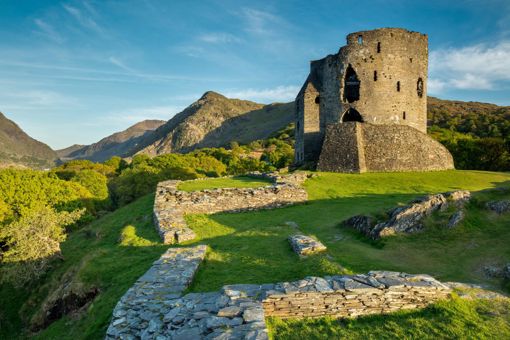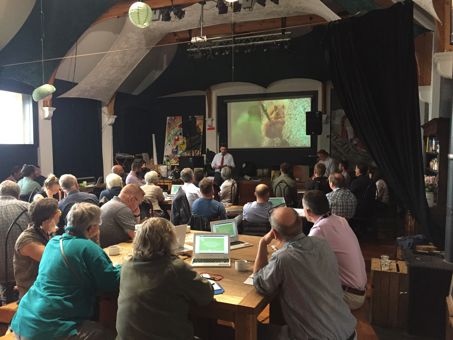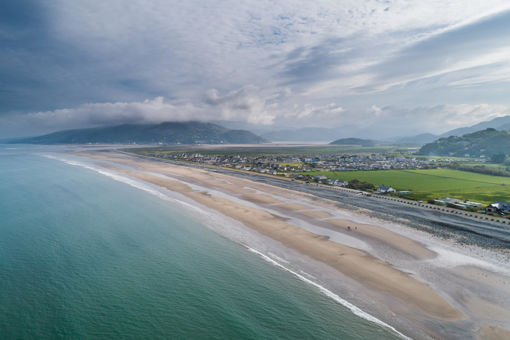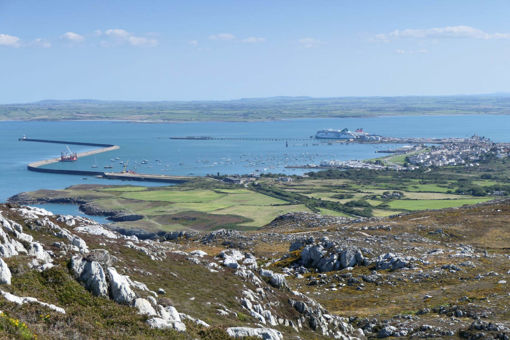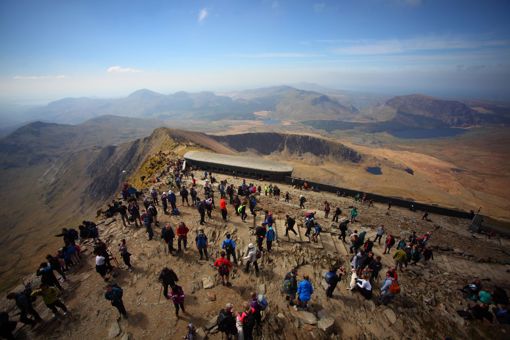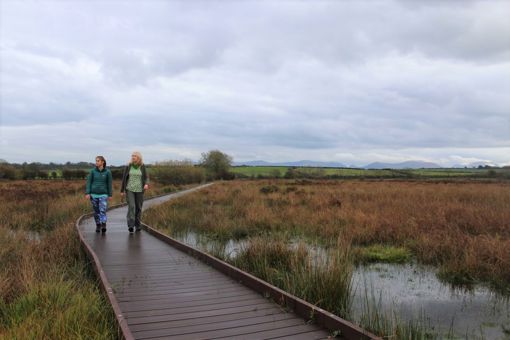Supporting sustainable land management
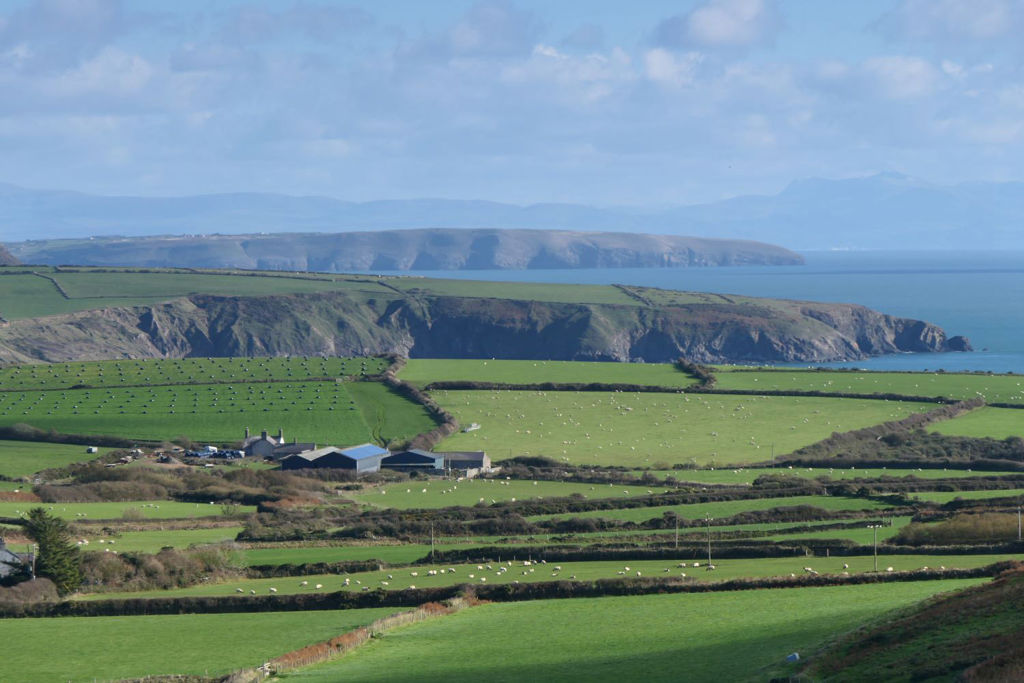
Supporting sustainable land management
Northwest Wales has an extraordinary landscape of spectacular mountains and coast that have been shaped by nature and people over time and are steeped in history and culture, making it the area’s main asset. The landscape has the power to inspire and enrich lives and attracts thousands of visitors each year.
Farming is the dominant land use in the North West region, although this theme is aimed at the broad reach of resource managers from community managed woodlands, Local Authorities, water companies, hospitals, schools and Natural Resources Wales (NRW) managed land which accounts for almost eight percent of the area. This Area Statement presents an opportunity to embark on an integrated approach to how we manage our most important and irreplaceable resource - our land and the water that flows off it, into our rivers and sea.
The uplands in Northwest Wales are a key and well-loved feature of the iconic and cultural landscape of the area. Uplands dominate much of the area’s landscape, with land above the upland boundary occupying 58 percent (2611km2), a third of which are exposed upland/plateau landscapes area, giving the region its distinct mountainous character. The uplands are important for biodiversity and landscape as well as being of value to farming, forestry, recreation, natural resources, culture and language.
The total length of picturesque coastline in Northwest Wales is 585km, which equates to 45.5 percent of the Welsh total. The area has some of the best bathing beaches and waters in Wales, including marine nature reserves, designated marine sites and some of Europe’s most important sand dune systems at Morfa Harlech, Morfa Dyffryn and Newborough. Coastal habitats provide many benefits to society including recreation and areas such as saltmarshes, sand dunes and shingle banks that provide natural flood protection for coastal communities and agricultural land. A Marine Area Statement has been developed that provides further information about the marine environment across Wales.
North West Wales has a number of important fisheries, including shell fisheries. The Conwy, Ogwen, Mawddach, Seiont, Dwyfor, Glaslyn, Clwyd and the Dwyryd catchments all support locally important salmon and sea trout fisheries and the Afon Dyfi and Dee catchments are nationally important salmon and sea trout rivers.
The salmon and sea trout stocks in all of the rivers in Northwest Wales are currently vulnerable and are predicted to remain so for the next five years, with only the Afon Ogwen predicted not to be ‘at risk’. Sustainable land and water management will be critical in helping to reduce the challenges to fish populations and improve numbers and resilience to ecological changes.
There are a number of lakes and reservoirs across Northwest Wales, all of which have significant importance for water supply, electricity generation, flood risk management, recreational use, well-being and ecology. Lakes are a sensitive and important receptor for land use practices, they provide a sink for sediment and nutrients within catchments. Most lakes in Northwest Wales provide multiple opportunities for use, for example, Llyn Cwellyn and Cefni provide water supply and are used recreationally while, Trawsfynnyd provides recreational use through fishing, walking and cycle routes as well as electricity generation. Llyn Tegid is a Special Area of Conservation that supports numerous important species and plays an important role in water supply and flood risk management on the River Dee. Llyn Celyn, Cowlyd and Peris are all important for electricity generation and Llyn Padarn is the only inland bathing water in Wales and provides a range of recreational opportunities, including: swimming, boating and fishing as well as an important habitat for arctic char and other fish species. Anglesey also has a number of small, shallow lakes which are an important part of the island’s wetland ecosystem.
Northwest Wales has rich mineral deposits that have shaped the mining and quarrying history of the area, and continues to do so with several deposits still actively quarried. The exploitation of mineral resources has a long history, with evidence of Bronze-Age copper mining on the Great Orme and Mynydd Parys as well as Roman use of Welsh slate. The slate landscape of Northwest Wales has been nominated to become an UNESCO World Heritage Site, to celebrate the industrial and cultural influence of slate on the region. It is strange now to stand in the landscape surrounded by the deserted quarries and imagine the noise and people that would have been there.
Many parts of Northwest Wales are designated landscapes, for example, Snowdonia National Park which covers 47 percent of the area, and two Areas of Outstanding Natural Beauty (AONB’s) that are located on the Llyn Peninsular and Anglesey. Put together, this means that approximately 56 percent of the land in the region is designated because of its cultural landscape value.
Sustaining the natural environment will help all of us. We now recognise that so much of what is good for the environment is also good for people’s well-being as we all benefit from the services our natural resources provide, from clean air and water provision to food production, materials and the economy.

Why this theme?
To facilitate the development of the Area Statement, Natural Resources Wales (NRW) held three workshops in North West Wales during July 2019 and a session for staff. Based on these discussions it is clear that there was support for opportunities for the 'Supporting Sustainable Land Management' theme among the stakeholders. The developed themes were taken back to the stakeholders for validation at our second round of engagement workshops in November and December 2019. More information and detail on this can be found in the Introduction to the Area Statement and in the Ways of Working Theme.
To inform this theme we have considered:
- Local knowledge from a series of structured independently facilitated workshops across North West Wales
- The priorities set in the Natural Resources Policy; Delivering Nature-Based Solutions, Increasing Renewable Energy and Resource Efficiency, Taking a Place-Based Approach
- Information from the State of Natural Resources Report (SoNaRR) on ecosystems and their resilience, and the risks to the benefits they provide
- The well-being assessments and plans, and the priorities that are emerging through Gwynedd and Anglesey and Conwy and Denbighshire Public Service Boards’
External stakeholders highlighted:
Sustaining the natural environment will help all of us, including: farmers, foresters, communities and individuals as we all benefit from the services our natural resources provide such as clean air and water provision, waste management, food production and materials.
To recognise that the farming industry is operating within a period of unprecedented uncertainty, although this gives farmers a unique opportunity to set a clear vision for the future of Welsh farming.
During the workshops, the importance of farming in the area was recognised strongly. As it is a backbone of the rural communities of North West Wales, we recognise its strengths and realise its potential. The reach and impact of farming goes beyond its economic value alone, it is essential as a means of ensuring the social, cultural and economic resilience and the well-being of rural communities.
How to manage water was also raised many times, both in terms of water quality and water quantity and how working together taking a sustainable catchment approach was critical.
Linking the culture and management of the land to new opportunities for the communities in places like Penmachno are key, and projects like Uwch Conwy project in Cwm Penmachno, or the LIFE project on Anglesey and the Llyn Peninsula are good models to follow. The Dyfi Biosphere, designated under UNESCO, is partly located within North West Wales. Biosphere Reserves explore locally how sustainable livelihoods, vibrant cultures and robust economies can be based on healthy environments. It would be good to strengthen links with the Biosphere and learn from the many projects they have undertaken.
This theme is closely linked with the Resilient Ecosystems theme, both of which will help deliver NRW’s Vital Nature Programme and ensure biodiversity and ecosystem networks are ecologically connected with the wider landscape, seascape and those that live and work there.
People told us this was really important to them:
- Continue to support and sustain farming in North West Wales, to work in harmony with nature
- Encourage local and sustainable food production
- Farmers recognise that the industry is operating within a period of unprecedented uncertainty and change; although this does give our farming communities a unique opportunity to reset their activities and start afresh with a different vision of farming in Wales
- There is a lack of farm specific, detailed information around aspects such as water and habitat/ecosystem quality. Farmers want to be able to measure what they currently have, and what impacts they might be having, before being able to fully understand how best to manage it
- The countryside has lost a lot of its wildlife. Agricultural intensification and specialisation has simplified the farmed environment and made it the domain of fewer species where once there was abundant diversity
- The management of the uplands in North West Wales is a key. They are a well-loved feature of the iconic and cultural landscape of the area. Uplands dominate much of the landscape of North West Wales, giving the region its distinct mountainous character
- Opportunities to deliver nature-based solutions that will help improve carbon stores, water and air quality, soil management and biodiversity
- The need to restore floodplains to reduce flood risk and improve water quality and manage water quantity
- Work at a catchment/landscape scale, delivering positive management solutions that protects both the complex habitats and diversity of species
- There is a need to increase well-located woodland for greatest ecosystem service value
- Habitat fragmentation is a threat to biodiversity, especially on agricultural land where there are many endangered species. Corridors between habitats are one way to counteract the effects of habitat fragmentation
- The work of farmers to produced cheap food has been taken for granted. Society and government need to decide what they want farmers to do in a way that makes economic sense that sustains our rural communities and natural habitat/biodiversity
- Keep a variety of different types of habitat within the North West Area – e.g. Mon Mam Cymru - Anglesey the mother of Wales was the bread basket of food production; northern urban coastal strip; mix of agricultural communities and higher altitude communities/environments in Meirionnydd
- Farmers need to be involved in designing a local 'sustainable farm management scheme' for their area as a one-size-fits-all approach to agricultural policy cannot deal with local issues. We need schemes that reflect the strengths and issues of an area
- The number of small-scale hydropower schemes in the National Park over the past few years has been massive, with potentially unmeasured impacts on the waterways they sit in – yet they deliver less electricity than one big wind turbine. The way we manage land and consider cumulative impact is critical
- Natural Resources Wales needs to lead the way and demonstrate sustainable management of natural resources in practice. by ensuring that our land and water management and business opportunities do not lead to emissions or environmental damage that can have consequences further afield
- Changes in farming practices, especially. Land drainage, more intensive use of grassland and the removal of hedgerows has affected biodiversity in the area
- We need to support and help integrate sustainable water management to improve water quality. This includes land management, flood risk and water company planning to ensure we have healthy rivers for fish
- It is important to recognise the positive contribution that farming makes to the environment in North West Wales, despite negative reports around some farming practices
- Common land is an important example of collaboration and we need to do more with this asset as it is important to wildlife and people
- Globally, peatlands store more carbon than the world’s rain forests, one of the world’s rarest habitats. When healthy peatlands contribution to a host of natural services, such as clean water and reducing flooding is taken into account, the case for their restoration becomes stronger
- Habitats need to be in the best possible condition if they are to be resilient against climate change. Agricultural land could be adversely affected by climate change unless it is robust enough to cope with and adapt to at least some of the effects
- In general, North West Wales has relatively low levels of intensive farming compared with other areas in Wales and England. The farming sector is the cornerstone of the rural economy and the farm structure in Wales is primarily small and medium sized enterprises of traditional family farms. More intensive farming takes place on improved lowland pasture on Anglesey and Pen Llyn. We need to look further than what farmers can do for themselves and their industry, changing the focus onto “what farming can do” for climate change, people’s well-being and biodiversity
Key points from assessment of data and evidence
According to the findings of the statutory State of Natural Resources Report (SoNaRR), all ecosystems lack resilience in one or more aspect/attribute. This means that their capacity to provide ecosystem services and benefits may be at risk. Changes in the overall resilience of these key ecosystems have been heavily influenced by farming, which in turn has been driven by the system of support under various agricultural policy regimes introduced in the UK post-war.
The Natural Resources Wales Policy states that Welsh Government is committed to considering the potential for introducing a more results-based approach to land-based support; for which the required outcomes are informed by local consultation and Area Statements.

What would success look like?
- Fundamental to success in achieving sustainable land management in the area, is ensuring the implementation of the principles of Sustainable Management of Natural Resources (SMNR)
- Driving change in how to manage land in the area, ensuring we have buy-in right from the start, to gain trust to collaborate and integrate work where we can. To deliver better outcomes by working together across the public, private and third sectors. Learning from projects such as the Cemaes Bay Partnership, to improve water quality and Uwch Gwyrfai Common Community Links project
- Having more woodland brought into sustainable management while new woodland expansion needs to be carefully targeted to ensure maximum public benefit, climate change mitigation, and that the right trees are planted in the right place
- Improved management and resilience of our ecosystems in rivers, lakes and land. In doing so, they will provide a wide range of benefits for land managers and society, water quality, flood risk management and carbon stores
- Maximising what the Welsh farming sector in North West Wales has to offer. We should be proud of the high quality products and food available, we need to be proud of that and be better at promoting that message
- The way to deal with flood risk needs to be dealt with differently, working with land managers in an integrated way, as flooding cannot be managed by simply building ever bigger and harder defences. Softer approaches are often more sustainable and deliver better environmental outcomes as they can achieve benefits such as: increasing infiltration, storing water, and slowing flows, reducing soil erosion and sedimentation of lakes and rivers, increasing carbon capture and storage, reconnecting rivers with species-rich floodplain wetlands, enhancing recreation opportunities and creating new habitats to help restore biological diversity
- We need better connectivity between and across the landscape, and in many cases, linking together the diverse range of habitats and species, such as increasing or improving hedgerows, fragmented woodland and coastal habitats. This is key to increasing water quality and water quantity management and enhancing biodiversity networks and help reduce loading. An example of an existing project would be Tir a Mor Llŷn (This project aims to maintain and expand a continuous strip of diverse habitat around the coastline, working with farmers)
- More upland management activities, such as the re-wetting and restoration of peat soils, which can regulate carbon and slow down the run-off of water to reduce flooding downstream
Benefits
There are multiple benefits for both people and wildlife that can be derived from sustainable land management. The resilience and healthy functioning ecosystems that support the flow of benefits that natural resources provide include economic, social and cultural benefits as well as contributing to the seven well-being goals, set out under the Well-being of Future Generations Act.
Key facts on the benefits from Welsh natural resources highlighted in the State of Natural Resources Report (SoNaRR)
- The Outdoor Recreation Sector benefits from the Local landscape
- 951 million litres of drinking water per day
- 5 million green tonnes of timber a year
- The Welsh woodland resource contributes a Gross Value Added (GVA) of £499.3M per annum to the Welsh economy
- 595,000 visitors to Snowdon annually, the third most visited destination in Wales
- 89m people visited the Snowdonia National Park in 2015
- Welsh soils store 410 million tonnes of carbon, as well as underpinning all of our agricultural production
- At a UK level, the annual value of pollination services to agriculture and horticulture is £690m
- 10 million overnight trips and 90 million-day visits from British visitors, with a further 932,000 international visits, generate a combined total expenditure of £2.87 billion to Wales (2014 figures)
- Evaluation of the Wales Coast Path found that the economic value derived from the health benefits of walking on the path was £18.2 million
- The Welsh historic environment sector supports 30,000 jobs and contributes £840m to national Gross Value Added
(GVA)
Opportunities identified related to this theme
All of the opportunities identified below will only be supported at environmentally appropriate locations.
Working with nature-based solutions from source to sea to restore and emulate the natural functions of catchments, floodplains and rivers in North West Wales. This could be done by working with Dwr Cymru/Welsh Water (DCWW) to undertake Sustainable Management of Natural Resources (SMNR) pilot catchments as part of their National Environment Plan (NEP) to find sustainable and more cost-effective solutions to achieving improved ecological quality.
This theme encourages opportunities to help develop sustainable production and provides the possibility of further development of local brands (Mon, Meirionnydd), which can be used to underpin quality outputs from the agri-food, timber, tourism, and environmental sectors.
Managing the landscape for the benefit of tourism, recreation, and local communities, the Welsh language and vibrant rural communities.
Work collaboratively in groups and build knowledge and skills to deliver shared outcomes, especially where ecosystems overlap farm holdings, common land and river catchments.
Working together to develop options for local agricultural schemes that deliver multiple benefits. Achieving sustainable land management starts with understanding locally what the issues are; we must make it easier to support farmers to maintain profits and manage their holdings in an environmentally friendlier way e.g. improved soil health and fertility, improved water quality, reduced nutrient losses to water, increased carbon storage and more habitats rich in biodiversity. We could explore opportunities to have pilot initiatives on farms where monitoring of water quality and species can be tracked and demonstrated, with best practice and lessons learned shared.
Working at a local level to avoid “one size fits all” approaches to farm subsidy and allow for distinctive differences in farming across the area as the area is varied with different and distinct habitats.
There is notably less woodland cover in the area (13.0 percent) and as low as 4.5 percent on Anglesey, which is lower than the national average of 15 percent for Wales. We need to ensure that the right trees are planted in the right places and this is an area that requires further research. New woodland expansion needs to be carefully targeted to ensure maximum public benefit. The management of woodland should be incorporated to a much greater extent into the farm economy.
Improving habitat connectivity and creation through restoring neglected woodland and derelict hedges can allow species to move between areas. Allowing grassy field margins can also provide additional biodiversity benefits by connecting habitats.
Strategic planting of trees around livestock/poultry units where appropriate can help to reduce ammonia drift reducing nitrogen deposition on sensitive environmental sites. It will also improve on farm water management, and contribute positively to animal health by providing shelter whilst increasing biodiversity and contributing to carbon storage.
NRW directly manages 34,622 hectares (almost 8 percent) of land in the North West Area. NRW should be an exemplary organisation in how we go about our day-to-day activities in managing our land and assets.
The public sector and (Non-Governmental Organisations) NGOs can also play an exemplar a role in delivering sustainable land management trying out new approaches to land and water management.
Working with Commons Associations by encouraging large scale agreements on common land, encouraging co-operation between commoners, on often large areas of grazed upland, is essential.
We recognise that water companies are increasingly taking innovative approaches to safeguard clean drinking water through catchment management with landowners and partners. We need to continue to work on reducing pesticides, fertilisers, nutrients, and pathogens at source and minimising the amounts getting into streams, rivers, and reservoirs. With a changing climate, we need to continue to ensure that the amount of water being taken from rivers, reservoirs or out of the ground can be sustained without damage to the environment now and in the future.
The long history of mining and quarrying in the area has left a legacy of disused quarries, mine spoil, shafts and underground workings. There is an opportunity to assess the potential impact of what reclamation, mitigation and remediation measures would be effective.
There is an opportunity for collaboration with partners to improve river, freshwater, and wetland habitats, working towards providing the best habitats for fish and native freshwater aquatic life in the North West, for example to create river and stream woodland corridors to help manage trap silt and reduce runoff. The restoration of riparian habitat, including buffer strips and tree planting (where appropriate) to keep rivers cool and reduce sediment load and run off that can affect water quality and smother fish eggs in river gravels. The restoration of the in-river structure, including the re-introduction of boulders or woody material in the Conwy, Llyfni, Mawddach, Clwyd and Dee Rivers where appropriate. This also links with our theme on Resilient Ecosystems. There are also opportunities for restoring natural geomorphological processes, in particular the removal of obstructions to fish passage that prevent access to spawning areas and natural gravel movements such as the removal of weirs that are no longer used on the Llyfni, Dyfi, Dee, Clwyd, Conwy Rivers.
Opportunities exist to extend the coastal belt inland, where conditions allow, to restore habitats possibly along the northern coast of the Llŷn Peninsula and Anglesey. The creation of buffer zones between cliff tops and areas of intensive agricultural management inland could be beneficial.
Opportunities to capitalise on local produce and local procurement as highlighted in the Encouraging a sustainable economy theme.
Who have we worked with to date?
- Invitations were sent to over 450 people and over the three workshops held, 100 people attended and contributed to the discussions. Natural Resources Wales (NRW) has developed the theme at those events and have been trying different ways to communicate with stakeholders to encourage continued involvement and interest in the local Area Statement
- A second round of workshops were held between November and December 2019 to build on the previous discussions. We have also spoken with partners and listened to their thoughts and feedback, including National Parks Authority meetings, Farming Union meetings and PSB workshops to help develop the content of the themes
- Over 500 invites went out for the second round of workshops in November/December 2019 with over 100 people in attendance.
- A series of online workshops were held in November and December 2020 where further discussions were focussed around each theme.
What are the next steps?
We will develop the area wide vision for this theme with stakeholders– with a broad remit and wide representation. We will identify potential partners and interested individuals/groups, gaps in knowledge and linkages with local strategies and action plans
We will use the information gathered during the stakeholder engagement events (external, internal, with partners such as the National Parks Authority) to guide the activities and influence organisational plans.
For each theme we will need to review what information and data we have so far, plan who we talk to next, look for theories of change, identify barriers and how to overcome and explore opportunities for appropriate action. The Area Statement will be iterative and will change and evolve over time. Groups will be responsible for determining when plans need to change and who needs to be involved in that process.
From this will be able to engage with and enthuse a broader group of stakeholders beyond the wider environmental sector in a targeted way and with a stronger focus on involving and engaging local groups and individuals. This could mean a variety of approaches, including: social media, traditional media, community meetings, drop-in sessions and the strengths of our partners so that we’re all working together to deliver the Area Statement vision and ambitions.

How does what we’ve proposed deliver Sustainable Management of Natural Resources (SMNR)?
- Collective action is needed to ensure connectivity of the appropriate ecological and cultural environment through sustainable land management practises including the management and creation of suitable connecting habitats at a landscape scale. As such, this will benefit the diversity of species found in the wider countryside
- Improving land management will have positive impacts such as improved soil health and fertility, improved water quality, reduced nutrient losses to water, increased carbon storage and more habitats rich in biodiversity
- Understanding existing land management practises and the creation of more green corridors including shrub, wild flower planting, hedgerow management, tree planting, meadows, grassland, ponds and conservation management will enable further connectivity of species and wildlife
- Improving mixed native woodland planting will improve biodiversity and provide woodland habitat connectivity benefits. Woodlands and forests are good for wildlife, as they help reduce noise pollution and improve air quality and can make a significant contribution to carbon storage
In addition, the appropriate control of Invasive Non Native Species (INNS) at an appropriate scale and replanting of tree cover affected by disease will also support ecosystem resilience.
The Area Statement will allow us all to make clear, evidence-based decisions, drawing not only on information that we hold but evidence our partners provide which is held locally. Much of the data will be made available to all through Natural Resources Wales’ new data portal. We appreciate that there are gaps in our evidence, but we’re working to plug them.
How do people get involved?
We welcome opportunities for the public to engage with us at any stage of the Area Statement process.
There is also a feedback form and an Email address: northwest.as@cyfoethnaturiolcymru.gov.uk should you wish to write to us with your ideas for developing action under this Theme.
To help as the facilitators of this process, NRW will:
- Work on certain aspects of the conversations that came out of the Area statement stakeholder engagement that identified opportunities and challenges to trial different approaches and develop new ways of working.

